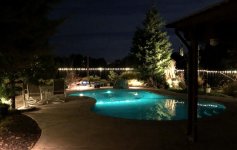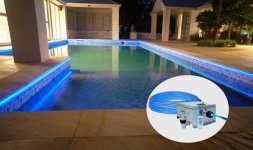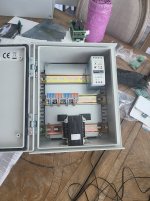Does anyone know where I would find a 12 volt DC power supply that's safe around pools? I'm seeing lots of transformers that provide 12 volt AC, but not DC
Pool 12v DC Power Supply?
- Thread starter negativez0
- Start date
You are using an out of date browser. It may not display this or other websites correctly.
You should upgrade or use an alternative browser.
You should upgrade or use an alternative browser.
- May 23, 2015
- 24,519
- Pool Size
- 16000
- Surface
- Plaster
- Chlorine
- Salt Water Generator
- SWG Type
- Pentair Intellichlor IC-60
An LED lighting project.What’s the application?
- May 23, 2015
- 24,519
- Pool Size
- 16000
- Surface
- Plaster
- Chlorine
- Salt Water Generator
- SWG Type
- Pentair Intellichlor IC-60
You can probably just use any standard AC/DC converter and then add it to an environmental enclosure that mounts on a wall. They don’t usually generate a lot of heat so any decent outdoor rated box should be fine. Then you can run direct burial 12/2 solid conductor to where you need it to go. Always good to use a cable color that’s different from the standard from the standard black multi-strand wiring used for 12VAC lighting.
- May 23, 2015
- 24,519
- Pool Size
- 16000
- Surface
- Plaster
- Chlorine
- Salt Water Generator
- SWG Type
- Pentair Intellichlor IC-60
I thought there was a certain type of power supply that should be used for pools to ensure the 120 volts has no way to make it to the low voltage side if it fails.
- Nov 12, 2017
- 11,961
- Pool Size
- 12300
- Surface
- Plaster
- Chlorine
- Salt Water Generator
- SWG Type
- Pentair Intellichlor IC-40
Where are the LEDs going? How close to the pool water will they be?
I've had good luck with these, for housing outdoor electrical components:
Wire the 120V side to a GFI outlet or circuit breaker, and keep the LEDs at least 5' from the pool water (or whatever your local building code requires, they may want more distance). That's about as safe as it's going to get, since you can do the same with 120V. 12V will just be that much safer, regardless of whatever protection the transformer does or doesn't provide (it won't matter).
This is assuming your pool is properly bonded. If it's not, or you're not sure, or if you don't know what that means, then you shouldn't be installing anything electrical outdoors, especially in, on or under the dirt, until you sort that out.
That said, if you want to do LED lighting right, and just one more time in your lifetime, buy from here:
 www.voltlighting.com
www.voltlighting.com
You'll pay a bit, but like I said, it'll be the last money you'll spend on garden lights. Their lifetime guarantee even covers the bulbs!
Then solder all the connections and cover those with DryConn wire nuts (or similar), and you'll never have a problem with shorts or corrosion. Like these:
I just described my LED garden and yard lighting, and other than three light bulbs, that VOLT sent me for free, it's been rock solid for 10 years (so far). VOLT has a large variety of types of lighting, to suit any application and any need.

Now if your project is completely unrelated to any of that, then, well, never mind...
I've had good luck with these, for housing outdoor electrical components:
Wire the 120V side to a GFI outlet or circuit breaker, and keep the LEDs at least 5' from the pool water (or whatever your local building code requires, they may want more distance). That's about as safe as it's going to get, since you can do the same with 120V. 12V will just be that much safer, regardless of whatever protection the transformer does or doesn't provide (it won't matter).
This is assuming your pool is properly bonded. If it's not, or you're not sure, or if you don't know what that means, then you shouldn't be installing anything electrical outdoors, especially in, on or under the dirt, until you sort that out.
That said, if you want to do LED lighting right, and just one more time in your lifetime, buy from here:
Factory Direct Landscape Lighting | VOLT® Lighting
Shop VOLT® for easy-to-install landscape lighting fixtures, low voltage transformers and LED outdoor light bulbs with lifetime warranties and fast shipping.
 www.voltlighting.com
www.voltlighting.com
You'll pay a bit, but like I said, it'll be the last money you'll spend on garden lights. Their lifetime guarantee even covers the bulbs!
Then solder all the connections and cover those with DryConn wire nuts (or similar), and you'll never have a problem with shorts or corrosion. Like these:
I just described my LED garden and yard lighting, and other than three light bulbs, that VOLT sent me for free, it's been rock solid for 10 years (so far). VOLT has a large variety of types of lighting, to suit any application and any need.

Now if your project is completely unrelated to any of that, then, well, never mind...
Last edited:
That looks great!Where are the LEDs going? How close to the pool water will they be?
I've had good luck with these, for housing outdoor electrical components:
Wire the 120V side to a GFI outlet or circuit breaker, and keep the LEDs at least 5' from the pool water (or whatever your local building code requires, they may want more distance). That's about as safe as it's going to get, since you can do the same with 120V. 12V will just be that much safer, regardless of whatever protection the transformer does or doesn't provide (it won't matter).
This is assuming your pool is properly bonded. If it's not, or you're not sure, or if you don't know what that means, then you shouldn't be installing anything electrical outdoors, especially in, on or under the dirt, until you sort that out.
That said, if you want to do LED lighting right, and just one more time in your lifetime, buy from here:
Factory Direct Landscape Lighting | VOLT® Lighting
Shop VOLT® for easy-to-install landscape lighting fixtures, low voltage transformers and LED outdoor light bulbs with lifetime warranties and fast shipping.www.voltlighting.com
You'll pay a bit, but like I said, it'll be the last money you spend. Their lifetime guarantee even covers the bulbs!
Then solder all the connections and cover those with DryConn wire nuts (or similar), and you'll never have a problem with shorts or corrosion. Like these:
I just described my LED garden and yard lighting, and other than three light bulbs, that VOLT sent me for free, it's been rock solid for 10 years (so far). VOLT has a large variety of types of lighting, to suit any application and any need.
View attachment 570420
Now if your project is completely unrelated to any of that, then, well, never mind...
My project is a bit more DIY as an tying all my landscape lighting into the same configuration as my animated Christmas lighting controllers.
I normally use Meanwell power supplies in waterproof boxes, but am trying to find the safest power supply to use on lights that are installed in the rails of our above ground pool.
- May 23, 2015
- 24,519
- Pool Size
- 16000
- Surface
- Plaster
- Chlorine
- Salt Water Generator
- SWG Type
- Pentair Intellichlor IC-60
You can get a pool code power transformer that will convert 120VAC to 12/13/14 VAC as those transformers are designed with isolated secondaries. Then just run the low voltage AC to wherever you need it and put a small AC/DC converter in a sealed junction box to run your DC lighting. As long as the power comes from the transformer, it’s as safe as you’ll get. The primary side of the transformer should be on a GFCI breaker but you won’t get that fault protection on the secondary side. Not that it really matters because low voltage DC is inherently safer.
- Nov 12, 2017
- 11,961
- Pool Size
- 12300
- Surface
- Plaster
- Chlorine
- Salt Water Generator
- SWG Type
- Pentair Intellichlor IC-40
I wouldn't ever attempt that, so I'm afraid I can't advise on it.lights that are installed in the rails of our above ground pool
If I had a mind to illuminate a pool in that way, I would use non-conductive fibre optic lighting cable(s) and locate the light source (and so it's power source), well away from the water.

Last edited:
- Nov 12, 2017
- 11,961
- Pool Size
- 12300
- Surface
- Plaster
- Chlorine
- Salt Water Generator
- SWG Type
- Pentair Intellichlor IC-40
And certainly not to your pool's metallic frame.This is assuming your pool is properly bonded. If it's not, or you're not sure, or if you don't know what that means, then you shouldn't be installing anything electrical outdoors, especially in, on or under the dirt, until you sort that out.
It's bondedAnd certainly not to your pool's metallic frame.
I was hoping to avoid adding more hardware, but this does sound like a pretty good method.You can get a pool code power transformer that will convert 120VAC to 12/13/14 VAC as those transformers are designed with isolated secondaries. Then just run the low voltage AC to wherever you need it and put a small AC/DC converter in a sealed junction box to run your DC lighting. As long as the power comes from the transformer, it’s as safe as you’ll get. The primary side of the transformer should be on a GFCI breaker but you won’t get that fault protection on the secondary side. Not that it really matters because low voltage DC is inherently safer.
It looks like this series of power supplies could work. It shows they have isolated outputs. Isn't that what to look for?

 led.meanwell.com
led.meanwell.com

XLG family, constant power mode and IP67 waterproof LED drivers from MEAN WELL
XLG Family, the high performance LED Drivers for various outdoor lighting applications from MEAN WELL with sample delivery in 48hrs.
- May 23, 2015
- 24,519
- Pool Size
- 16000
- Surface
- Plaster
- Chlorine
- Salt Water Generator
- SWG Type
- Pentair Intellichlor IC-60
It looks like this series of power supplies could work. It shows they have isolated outputs. Isn't that what to look for?

XLG family, constant power mode and IP67 waterproof LED drivers from MEAN WELL
XLG Family, the high performance LED Drivers for various outdoor lighting applications from MEAN WELL with sample delivery in 48hrs.led.meanwell.com
That would still be a 120V high voltage appliance and it would have to follow pool building code rules which would most likely mean that it is powered by a GFCI protected source and that it is at least 5ft from the edge of the water (more than that if local code requires a greater distance). You would then have to run the output wiring to whatever lighting you have.
- Nov 12, 2017
- 11,961
- Pool Size
- 12300
- Surface
- Plaster
- Chlorine
- Salt Water Generator
- SWG Type
- Pentair Intellichlor IC-40
Note the case studies on their homepage don’t mention anything about swimming pools. That doesn’t mean it can or cannot be used with a pool, it just means they’re not bragging about it. You might send an inquiry to them, asking if their product line is appropriate for your application.
- Jun 1, 2018
- 13,971
- Pool Size
- 26000
- Surface
- Vinyl
- Chlorine
- Salt Water Generator
- SWG Type
- Hayward Aqua Rite (T-15)
All components must be ul rated for use around pools
- Nov 12, 2017
- 11,961
- Pool Size
- 12300
- Surface
- Plaster
- Chlorine
- Salt Water Generator
- SWG Type
- Pentair Intellichlor IC-40
Thank you 88! The page you link articulates everything I was thinking, and everything I would be worried about, and some things I didn't even know to worry about! It explains exactly why my instinct was to write "I wouldn't ever attempt that...", and I'm better (and crazier) than most DIYers at this kind of thing. (You can ask just about anyone here about the "crazy" part!!)All components must be ul rated for use around pools
The article was written a while ago, and so maybe there have since been lighting systems invented that would comply, but, IMO, even if true, it's just not worth the risk. Even if you could get a safe system installed, how are you going to safeguard it against future damage or rambunctious kids or some other unforeseen failure to it that would render it unsafe (answer: you can't). I personally wouldn't swim in any pool with a DIY lighting system bolted to it, especially an AGP with a metal frame, that was "invented" by someone that had to come to an Internet forum to ask how to do it (and then accept answers from random strangers about the same). And I would not be happy (to put it politely) to learn that someone let me or my kids swim in their pool with such a thing without me knowing about it. Sorry to be so blunt (rude?), but that's my opinion on the subject.
I think outdoor lighting is amazing, and have a ton of it, but none of it is near my pool. So I get your interest in it. I pointed you to a solution (VOLT) that would safely transform your yard, and give you all the "wow factor" you could ever want. I'm strongly encouraging you to rethink your project, and achieve your goal of adding some real cool lighting in some other way, using time-tested professional components that are expressly designed and rated for it.
Last edited:
- Nov 12, 2017
- 11,961
- Pool Size
- 12300
- Surface
- Plaster
- Chlorine
- Salt Water Generator
- SWG Type
- Pentair Intellichlor IC-40
Don't take my word for it. Google "man dies fixing his pool light." You'll find a slew of incidents where DIYers and pros alike thought they knew what they were doing while messing around with pool electrical systems. Unfortunately, most of them are no longer "available" to tell their side of the story.
- Oct 25, 2015
- 5,220
- Pool Size
- 25000
- Surface
- Plaster
- Chlorine
- Salt Water Generator
- SWG Type
- CircuPool RJ-60 Plus
I would consider a DIN rail mounted box and run the low voltage through conduit to the pool. Very easy to mount and there are many, many choices for DIN rail mounted DC power supplies at reasonable cost. Not sure how many amps you need but would be easy to mount next to the pool sub panel and power directly from 110 or 240 vac. Also, @Katodude had played around with LED strip lights in his pool. He may have some great suggestions. You can find NEMA weather-proof rated boxes at Vevor and Altelix. Google DIN 120vac to 12v DC power supplies for a huge # of options. Below is a box I built recently.
I hope this helps.
Chris

I hope this helps.
Chris

Similar threads
- Replies
- 7
- Views
- 110

